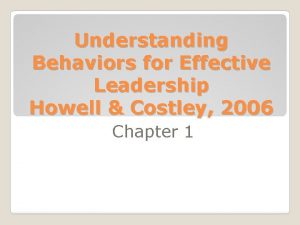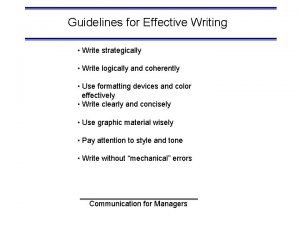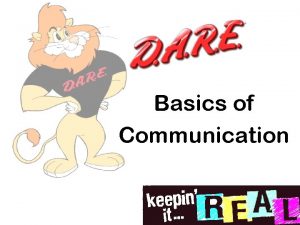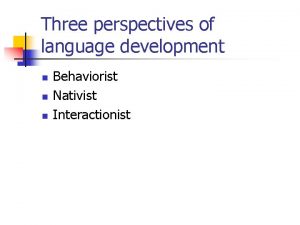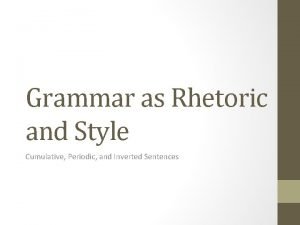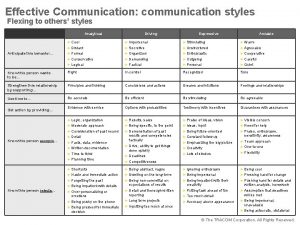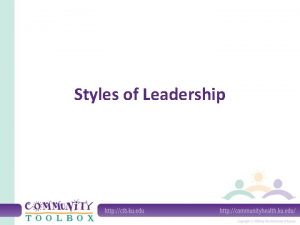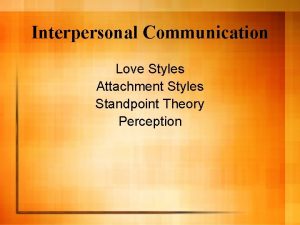Understanding Your Communication Style Communication Styles Effective Leaders


































- Slides: 34

Understanding Your Communication Style

Communication Styles Effective Leaders – Have the ability to mirror the behaviors of persons they communicate with. Mirroring – Describes a situation where one person intentionally matches the body language of the individual they are meeting with. It requires that we pay close attention to the speech patterns and gestures of the person we are talking to.

Communication Style Defined The impression that others form about us are based on what they observe us saying and doing. The patterns of behavior that others can observe can be called communication style. We all have a unique style. Getting to know your style will help you achieve greater self-awareness and improve relationships. 3 Key Relationships with self, with another person, and with members of a group.

“Everyone has had the experience of saying or doing something that was perfectly acceptable to a friend or coworker and then being surprised when the same behavior irritated someone else” Understanding other people’s communication styles improves working relationships by increasing our acceptance of other people and their way of doing things. Knowledge of the various communication styles helps us communicate more effectively with people who differ from us.

Fundamental Concepts Supporting Communication Styles Individual differences exist and are important Length of eye contact Use of Gestures Speech Patterns Facial Expressions The degree of Assertiveness people project to others We can identify a person’s unique communication style by carefully observing these patterns of behavior.

Fundamental Concepts Supporting Communication Styles Individual style differences tend to be stable throughout life There is a limited number of styles A communication style is a way of thinking and behaving – How someone likes to do something

Fundamental Concepts Supporting Communication Styles To create the most productive working relationships, it is necessary to get in sync with the behavior patterns (communication style) of the people you work with. Differences between people can be a source of friction unless you develop the ability to recognize and respond to the other person’s style. It’s an important ability to Know when and how to adapt your own preferred style to another’s. It will help you deal with people more effectively.

The Communication Style Model In regards to your preferences not skills or abilities Low Dominance High Dominance People who are high in dominance must sometimes curb their desire to express strong opinions and initiate demands. A person who is perceived as being extremely strong-willed and inflexible will have difficulty establishing a cooperative relationship with others.

The Dominance Continuum Not meant to be a precise instrument, but it will provide you with a general indication of where you fall on each of the scales. Dominance – The tendency to display a “take charge” attitude. Every person falls somewhere on the dominance continuum. Low Dominance – These people are characterized by a tendency to be cooperative and eager to assist others. They tend to be low in assertiveness and are more willing to be controlled by others. High Dominance – These people give advice freely and frequently initiate demands. They are more assertive and tend to seek control over others.

Dominance Indicator Successful people can be found at all points on the continuum In regards to your preferences not skills or abilities Low Dominanc e Cooperative Submissive Accommodating Hesitant Reserved Compromising Cautious High Dominanc e -------------------------------------------------- Competitive Authoritative Domineering Decisive Outgoing insistent Risk Taking

Dominance Indicator Successful people can be found at all points on the continuum In regards to your preferences not skills or abilities Low Dominanc e Patient Passive Quiet Shy Supportive Relaxed Restrained High Dominanc e -------------------------------------------------- Hurried Influential Talkative Bold Demanding Intense Assertive

Critical Thinking Challenge In regards to your preferences not skills or abilities o Determine your own place on the dominance Scale. o Rate yourself on each scale by placing a checkmark at a point along the continuum that represents the degree that you feel you exhibit each of the characteristics. o Think about your friends and classmates ü Who is most dominant in your circle? ü Who is least dominant in your circle? o Can you recall occasions when either low dominance or high dominance created a barrier to effective interpersonal relations?

The Sociability Continuum Not meant to be a precise instrument, but it will provide you with a general indication of where you fall on each of the scales. Sociability – Can be defined as the tendency to seek and enjoy social relationships. Low Sociability – Is more reserved and formal in social relationships. They tend to control their feelings. High Sociability – Usually express their feelings freely. They tend to be open and talkative and like personal associations.

The Sociability Indicator Successful people can be found at all points on the continuum In regards to your preferences not skills or abilities Low Sociability Discipline Controlled Serious Methodical Calculated Guarded Introverted High Sociability -------------------------------------------------- Easygoing Expressive Lighthearted Unstructured Spontaneous Open Extroverted

The Sociability Indicator Successful people can be found at all points on the continuum In regards to your preferences not skills or abilities Low Sociability Aloof Formal Reserved Cautious Conforming Self-Controlled Restrained High Sociability -------------------------------------------------- Friendly Casual Proactive Carefree Unconventional Open Impulsive

Critical Thinking Challenge In regards to your preferences not skills or abilities o Determine your own place on the Sociability Scale. o Rate yourself on each scale by placing a checkmark at a point along the continuum that represents the degree that you feel you exhibit each of the characteristics. o Think about your friends and classmates ü Who is highest on the sociability indicator? ü Who is the lowest? o Can you recall occasion when high sociability or low sociability created a barrier to effective interpersonal relations?

Four Basic Communication Styles o Dominance and sociability can be combined to form a rather simple model that will tell you more about your communication style. o The communication style model will help you identify your most preferred style. o Dominance is represented by the horizontal axis o Sociability by the vertical axis o The model is divided into quadrants, each representing one of four communication styles: emotive, director, reflective, or supportive. o As you review the descriptions of these styles, you will likely find one that is “most like you” and one or more that are “least like you. ”

The Communication Style Model In regards to your preferences not skills or abilities High Sociability Supportive Emotive Low Dominance High Dominance Reflective Director Low Sociability

Emotive Style o The upper –right hand quadrant combines high sociability and high dominance. o Displays spontaneous, uninhibited behavior. The emotive person is more apt to talk rapidly, express views with enthusiasm, and use vigorous hand gestures.

Emotive Style o Displays the personality dimension as extroversion. Extroverts typically enjoy being with other people and to be active and upbeat. The emotive person likes informality and usually prefers to operate on a fist-name basis. o Possesses a natural persuasiveness. Combining high dominance and high sociability, this person finds it easy to express his or her point of view dramatically and forcefully.

Director Style o The lower–right hand quadrant represents a communication style that combines high dominance and low sociability. o Projects a serious attitude. They usually communicate with a no-nonsense attitude and give the impression that they cannot have fun.

Director Style o Expresses strong opinions. With firm gestures and a tone of voice that communicates determination, the director projects the image of someone wants to take control. o May project indifference. It is not easy for the director to communicate a warm, caring attitude. He or she does not find it easy to abandon the formal approach in dealing with people.

Reflective Style o The lower–left hand quadrant of the communication style model features a combination of low dominance and low sociability. o Expresses opinions in a disciplined, deliberate manner. The reflective person does not seem to be in a hurry. He or she expresses measured opinions. Emotional control is a common trait of this style.

Reflective Style o Seems to be preoccupied. The reflective person is rather quiet and may often appear preoccupied with other matters. As a result, he or she may seem aloof and difficult to get to know. o Prefers orderliness. The reflective person prefers an orderly work environment. At a meeting, this person appreciates an agenda. A reflective person enjoys reviewing details and making decisions slowly.

Supportive Style o The Upper–left hand quadrant combines low dominance and high sociability. o Listens attentively. Good listeners have a unique advantage in many occupational settings. This is especially true of loan officers, sales personnel, and supervisors. The talent comes more naturally to the supportive person.

Supportive Style o Avoids the use of power. Supportive persons are more likely to rely on friendly persuasion than power when dealing with people. They like to display warmth in their speech and written correspondence. o Makes and expresses decisions in a thoughtful, deliberate manner. Supportive persons appear low-key in a decision-making role.

Variation Within Your Communication Style No one conforms completely to one style. Keep in mind that communication style is just one dimension of personality. It refers only to those behaviors that others can observe. Communication Style Conflicts: Orderliness and structure Spontaneous and unstructured

Variation Within Your Communication Style Communication styles also vary in intensity. For example, a person may be either moderately or strongly dominant. There are three communication style zones that radiate outward from the center. Under certain conditions, people will abandon their preferred style temporarily.

Communication Style Zones Zone 1: Less intense and may be more difficult to identify the preferred communication style. They will not be as obvious in their gestures, tone of voice, speech patterns, or emotional expressions. Zone 2: Greater intensity then Zone 1. Zone 3: Excess Zone is characterized by a high degree of intensity and rigidity. It is called the “danger zone” because people become inflexible and display a lack of versatility. Extreme intensity in any quadrant is bound to interfere with good human relations.

Behaviors Displayed in the Excess Zone People often move into the excess zone when they are under stress or not feeling well. A person who feels threatened or insecure may also move into the excess zone. Even a temporary excursion into the excess zone should be avoided if at all possible. Emotive Style: Tends to express highly emotional opinions, is outspoken to the point of being offensive, seems unwilling to listen to the views of others, and uses exaggerated gestures and facial expressions.

Behaviors Displayed in the Excess Zone Director Style: Is determined to come out on top, will not admit to being wrong, appears cold and unfeeling when dealing with others, and tends to use dogmatic phrases such as “always, ” “never, ” or “you can’t”. Reflective Style: Tends to avoid making a decision, seems overly interested in detail, is very stiff and formal when dealing with others, and seeks to achieve perfection. Supportive Style: Attempts to win approval by agreeing with everyone, constantly seeks reassurance, refuses to take a strong stand, and tends to apologize a great deal.

Tips on Style Identification Focus your full attention on observable behavior. Best clues for identifying styles are nonverbal. Be observant of people’s gestures, posture, and facial expressions, and the rapidity and loudness of their speech. Animated facial expressions and high volume, rapid speech are characteristic of the emotive style. Infrequent use of gestures, speaking in a steady monotone, and few facial expressions are reflective. The person tends to be blunt and to the point and makes strong statements, you are likely observing a director.

Tips on Style Identification Let’s assume that the clues indicate that the person is low in dominance. This means you can automatically eliminate the emotive and director styles because both are characterized by high dominance. The next step is to place the person on the sociability continuum. If the clues indicate that the person is low in sociability, you automatically eliminate the supportive style. Your initial perception of another person’s style should not be carved in stone. You should continue to collect new information and reassess your initial observations.

Versatility: The Third Dimensions 1 and 2 are Dominance & Sociability Persons who can create and maintain interpersonal relations with others, regardless of their communication styles, are displaying versatility. Versatility can be defined as acting in ways that earn a social endorsement. People give us their endorsement when they feel comfortable and non-defensive with us. Versatile people recognize that they can control their half of relationships and that it is easier to modify themselves than it is to modify others.
 Covey 8 habits
Covey 8 habits Effective communication with your teenager
Effective communication with your teenager Understanding behaviors for effective leadership
Understanding behaviors for effective leadership Tabs for leaders book army
Tabs for leaders book army Imitate the faith of your leaders
Imitate the faith of your leaders Hebrews 13 7
Hebrews 13 7 Guidelines for effective writing
Guidelines for effective writing Give us your hungry your tired your poor
Give us your hungry your tired your poor Analytical intuitive functional and personal
Analytical intuitive functional and personal Site:slidetodoc.com
Site:slidetodoc.com Listening in interpersonal communication
Listening in interpersonal communication Avoiding turtle conflict management
Avoiding turtle conflict management Communication style driver
Communication style driver Orality examples
Orality examples 3 styles of communication
3 styles of communication Black and white communication styles
Black and white communication styles Communication styles survey
Communication styles survey Communication styles
Communication styles Communication styles
Communication styles Dare communication styles
Dare communication styles Communication styles crossword
Communication styles crossword Parts of a block style letter
Parts of a block style letter Formal to informal
Formal to informal What is an informal style
What is an informal style Referential style vs. expressive style
Referential style vs. expressive style Plain style poetry
Plain style poetry Cumulative periodic and inverted sentences
Cumulative periodic and inverted sentences Understanding your stakeholders
Understanding your stakeholders Trust in the lord lean not on your own understanding song
Trust in the lord lean not on your own understanding song The ability to locate interpret and apply information
The ability to locate interpret and apply information Chapter 1 health and wellness fundamentals
Chapter 1 health and wellness fundamentals Understanding your health and wellness
Understanding your health and wellness Lean not on your own understanding
Lean not on your own understanding Chapter 1 understanding health and wellness
Chapter 1 understanding health and wellness Let's check your understanding
Let's check your understanding


